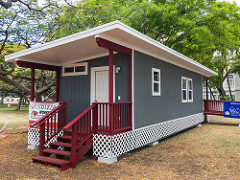Over the past years, the Bay Area has seen increasing legalization and deregulation of accessory dwelling units (ADUs), discrete self-contained living units on the same parcel as an existing home or property. In 2017, when the Palo Alto City Council voted 6-2 to deregulate the units, some believed that the floodgates had opened, the gold rush was on and there would soon be a ‘granny flat’ in every backyard.
On the evening of the 2017 vote, Palo Alto Mayor Liz Kniss — who was then the Vice Mayor — said that the rule changes answered concerns about affordable rentals and multigenerational housing that she had heard in the 2016 election.
“There is no question that the biggest question in this community was about housing,” she said. “It was the clearest clarion yell that came out of that particular race that I heard … Tonight we can actually deliver on a promise.”
ADUs, often referred to as ‘granny flats’ for their common use housing an aging family member, cost between $30,000 and $300,000 to install, usually in a building or backyard. De-regulating them has been popular policy –– a way to add some housing density without changing infrastructure or the look of neighborhoods. Optimistic public officials praised ADUs as an opportunity to provide much-needed rental space for middle-income workers, while others emphasized their potential to serve low-income communities and enable multigenerational living.
Ultimately, however, according to a quarterly update from Planning and Development Services, the city has received only 133 permit applications since June 2017 — fewer than pro-housing advocates had hoped for. At a Jan. 13 meeting of City Council, Kniss wondered about ways to make the permitting process less intimidating.
“Is the issue that the people are thinking about it and deciding not to do it?” she asked in the meeting. “Are they coming to us and deciding it’s such a complicated process and they’re not going to do it? It seems as though this is really few for something that we really did a big, concerted effort to present to the public.”
Concerns about overly bureaucratic ADU permitting processes and arbitrary standards had prompted the passage of state bills such as SB 13, a bill signed into law in October by Governor Newsom that prohibits local governments from demanding certain parking and coverage requirements.
That Jan. 13 meeting of City Council was a response to the new state laws, as council-members unanimously voted to do away with a host of previous requirements for new construction or renovation of ADUs.
The meeting saw the minimum setback of units reduced to four feet, removed a requirement that required that units not take away a parking space, and explicitly specified that an ADU would be permitted next to a single-family home if its height did not go over 16 feet and its square footage did not go over 800 square feet.
The new city changes would also allow over-the-counter rapid approval for certain less-disruptive types of new units, such as detached ADUs on multifamily lots and “junior accessory dwelling units” created by simply turning a bedroom or spare room into a unit.
The trend toward deregulation on the local level is likely to continue, as city planners bring legal requirements into alignment with loosening state standards and ADUs remain politically popular.
Contact Cooper Veit at cveit ‘at’ stanford.edu
